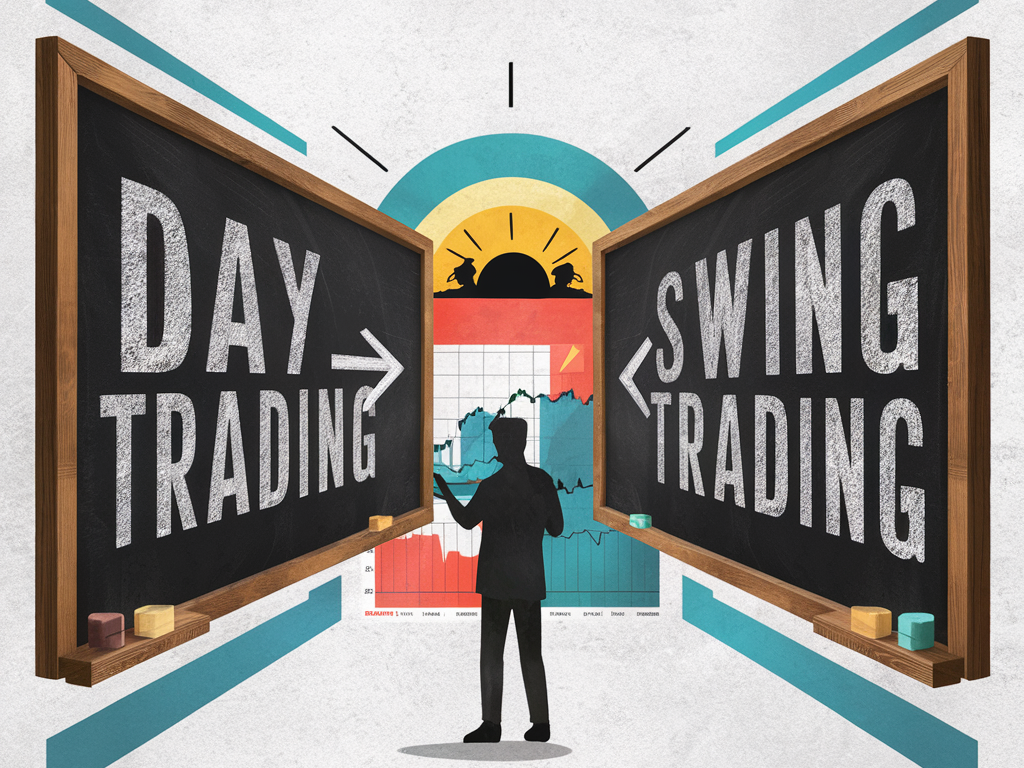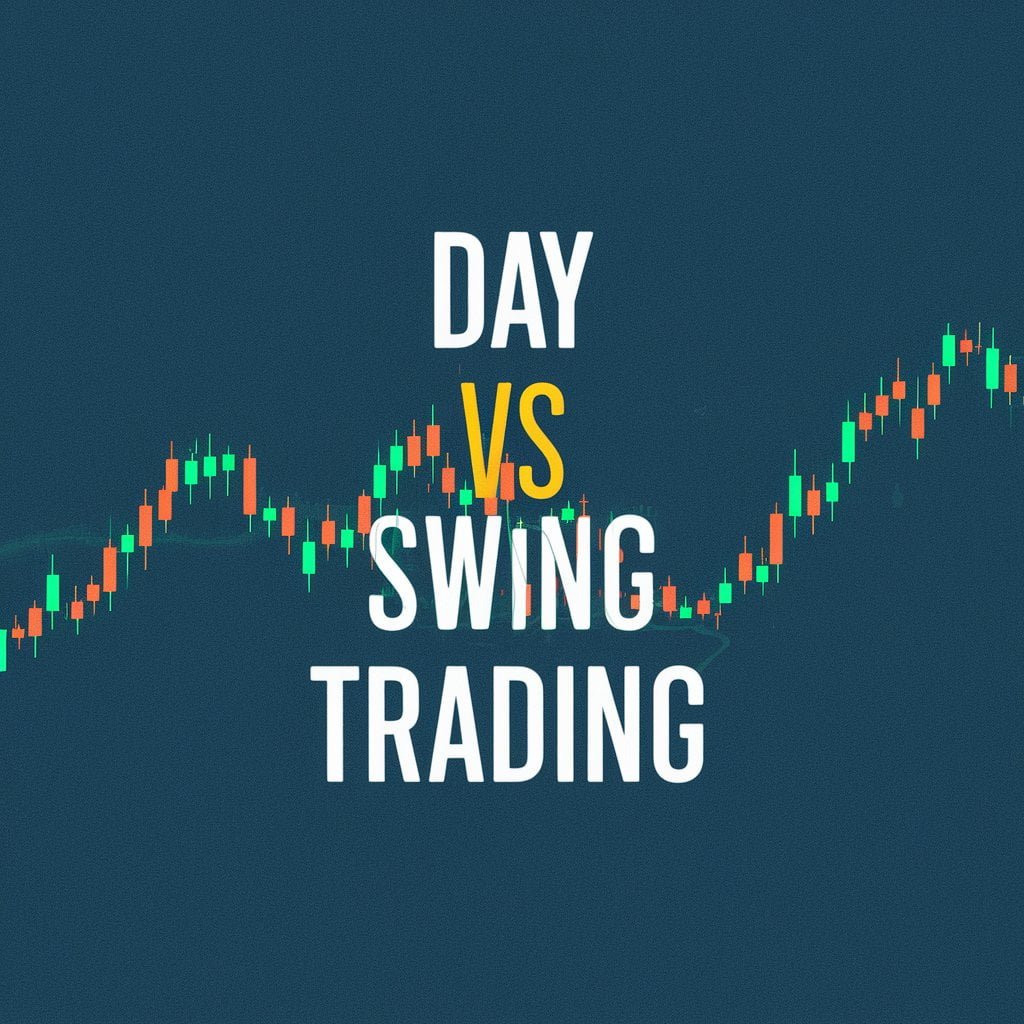
How to Choose Between Day Trading and Swing Trading
Click Here To Save Time
Time Saver
– Day trading and swing trading are popular trading strategies with different time commitments and risk levels.
– Day trading involves buying and selling stocks within the same day, focusing on short-term price movements.
– Swing trading allows traders to hold stocks for days or weeks, targeting larger price swings over time.
– Day traders require more time, higher risk tolerance, and quick decision making skills compared to swing traders.
– Swing trading is less time-consuming and generally less stressful but still carries overnight risks.
– Choosing between the two strategies depends on individual goals, risk tolerance, and available capital.
Introduction
When you step into the world of trading, you’ll find there are numerous strategies you can use to achieve your financial goals. Two of the most popular methods are day trading and swing trading.
Both strategies have their unique approaches to the stock market, requiring different levels of time, risk, and expertise.
Knowing the difference between these two can help you choose the right path for your trading journey.
What Is Day Trading?

Day trading is a fast-paced strategy where traders buy and sell financial instruments like stocks, options, or futures within a single trading day.
The main goal is to make quick profits by taking advantage of small price movements. Day traders don’t hold their positions overnight, avoiding the risks that come with after-hours market fluctuations.
Characteristics of Day Trading:
– High Time Commitment: Day traders need to watch the market closely throughout the day and be ready to make rapid decisions.
– Focus on Technical Analysis: Since day traders are concerned with short-term movements, they rely heavily on technical analysis to guide their trades.
– High Risk and Reward: While the potential for profit is high, day trading can also lead to significant losses if the market moves against the trader’s expectations.
Example of Day Trading
Imagine a day trader who starts their day with $10,000 in their trading account.
They notice that a particular stock is experiencing high volatility due to an earnings report. Using technical analysis tools like moving averages and the RSI (Relative Strength Index), they decide to buy 100 shares at $100 each.
Within a few hours, the stock price increases to $102, and the trader sells all shares, securing a quick $200 profit. However, if the stock had dropped instead, the trader could have faced losses just as quickly.
What Is Swing Trading?
Swing trading is a slower-paced strategy where traders hold onto their investments for several days or even weeks. The goal is to profit from larger price swings that occur over a more extended period.
Swing traders are less concerned with day-to-day fluctuations and focus more on the overall trend of the stock.
Characteristics of Swing Trading:
– Less Time-Intensive: Unlike day traders, swing traders don’t need to monitor the market all day. They typically check in once or twice a day to manage their trades.
– Combination of Technical and Fundamental Analysis: Swing traders often use both technical analysis and fundamental analysis to make informed decisions about when to enter and exit a trade.
– Moderate Risk: While there’s still risk involved, swing trading is generally less risky than day trading because it allows for more considered decisions and avoids the rush of intraday trading.
Example of Swing Trading
Consider a swing trader who spots a stock trending upward over the past few months. After analyzing the stock’s recent pullback to a support level, they decide to buy 200 shares at $50 each.
Over the next two weeks, the stock price gradually increases to $55, and the trader sells their shares for a $1,000 profit.
Unlike day trading, swing trading allows the trader to capitalize on longer-term price movements without the need for constant monitoring.
Day Trading vs. Swing Trading: What’s the Difference?

Time Horizon
– Day Trading: All positions are closed within the same day, which means no overnight exposure to the market’s unpredictability.
– Swing Trading: Positions can be held for days or even weeks, allowing traders to take advantage of broader market trends.
Trading Frequency
– Day Trading: Involves frequent trades throughout the day, sometimes making dozens of trades in a single session.
– Swing Trading: Involves fewer trades, with the focus on capturing significant price movements over a longer period.
Risk Tolerance
– Day Trading: Requires a higher risk tolerance as trades are fast-paced, and losses can accumulate quickly.
– Swing Trading: Involves lower immediate risk, but holding positions overnight exposes traders to market events that can happen outside of regular trading hours.
Capital Requirements
– Day Trading: Typically requires more capital due to the higher volume of trades and margin requirements.
– Swing Trading: Can be done with less capital since it involves fewer trades and lower transaction costs.
Case Study: Comparing Day Trading and Swing Trading in Action
Day Trading Case Study
Let’s say there’s a major announcement from a tech company that could potentially increase its stock price.
A day trader sees this as an opportunity and buys 500 shares at $200 each. The stock price quickly rises to $205, and the trader sells, making a $2,500 profit. However, by the end of the day, the stock drops back down to $195 due to broader market concerns.
The day trader’s quick action allowed them to profit without the risk of holding the stock overnight.
Swing Trading Case Study
On the other hand, a swing trader might notice that the same stock has been on an upward trend over several months.
After the price drops to $195, they buy 300 shares, anticipating a recovery. Over the next three weeks, the stock rises to $215, and the swing trader sells for a $6,000 profit.
While they had to wait longer for their profits, the swing trader benefited from the broader trend without needing to time the market as precisely as the day trader.
Pros and Cons of Day Trading
Pros:
– Potential for quick profits within the same day.
– No overnight risk since positions are closed daily.
– Opportunities to make multiple trades and profits in a single day.
Cons:
– Requires intense focus and constant monitoring of the market.
– High risk of losses due to the fast-paced nature of the strategy.
– Higher transaction costs due to frequent trading.
Pros and Cons of Swing Trading
Pros:
– More time to make informed decisions, reducing the stress of trading.
– Lower transaction costs due to fewer trades.
– Potential for larger profits by capturing bigger market moves.
Cons:
– Overnight risk due to holding positions for several days or weeks.
– Requires patience as profits may take longer to realize.
– Less frequent trading opportunities compared to day trading.
Which Trading Strategy Is Best for You?

Choosing between day trading and swing trading comes down to your personal preferences, risk tolerance, and financial goals.
If you thrive in fast-paced environments, have a higher risk tolerance, and can dedicate significant time to trading, day trading might be the right choice for you.
On the other hand, if you prefer a more relaxed approach, have a lower risk tolerance, and want to invest with a longer-term perspective, swing trading could be a better fit.
Conclusion
Both day trading and swing trading offer unique approaches to making profits in the stock market. While day trading provides quick opportunities to make profits, it requires significant time, effort, and a high tolerance for risk.
Swing trading, although slower, allows traders to capitalize on longer-term trends with potentially lower risks and less time commitment.
Understanding the differences between these two strategies and evaluating your own goals, time, and risk tolerance is essential for choosing the right path in your trading journey.
Leave a Reply
You must be logged in to post a comment.